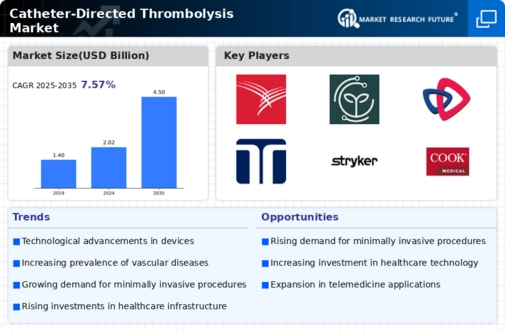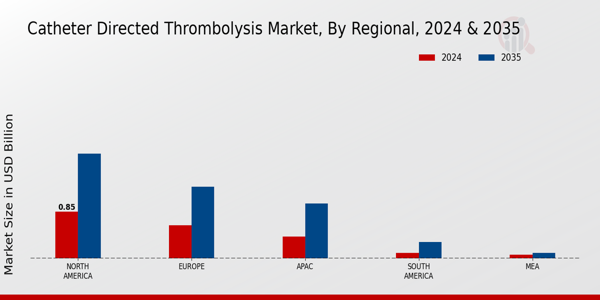Market Growth Projections
The Global Catheter-Directed Thrombolysis Market Industry is poised for substantial growth, with projections indicating a market size of 2.02 USD Billion in 2024 and an anticipated increase to 4.5 USD Billion by 2035. This growth trajectory suggests a compound annual growth rate (CAGR) of 7.55% from 2025 to 2035. Factors contributing to this expansion include rising incidences of vascular diseases, technological advancements in catheter systems, and increased awareness among healthcare providers and patients. The convergence of these elements is likely to create a favorable environment for market players, encouraging innovation and investment in catheter-directed thrombolysis solutions.
Growing Geriatric Population
The aging global population is a critical driver for the Global Catheter-Directed Thrombolysis Market Industry. As individuals age, they become more susceptible to vascular diseases, which increases the demand for effective treatment options. The United Nations projects that the number of people aged 65 and older will reach 1.5 billion by 2050, highlighting the urgent need for targeted therapies. Catheter-directed thrombolysis offers a minimally invasive approach, making it particularly appealing for older patients who may have comorbidities. This demographic shift is likely to propel market growth, with projections indicating a significant increase in market size, reflecting the growing need for specialized vascular care.
Government Initiatives and Funding
Government initiatives aimed at improving healthcare infrastructure and funding for vascular disease treatments are pivotal for the Global Catheter-Directed Thrombolysis Market Industry. Various countries are implementing policies to enhance access to advanced medical technologies, including catheter-directed thrombolysis. For example, increased funding for research and development in vascular treatments is likely to spur innovation and improve patient access to these therapies. Such initiatives not only support healthcare providers but also encourage the adoption of catheter-directed thrombolysis as a standard treatment option. This supportive environment is expected to contribute to the market's growth, aligning with the anticipated increase in market value over the coming years.
Increasing Awareness and Education
The Global Catheter-Directed Thrombolysis Market Industry benefits from heightened awareness and education regarding vascular health and treatment options. Healthcare providers and patients are increasingly informed about the risks associated with untreated thromboembolic events, leading to a greater demand for catheter-directed therapies. Initiatives by health organizations to promote education on vascular diseases and their management are contributing to this trend. As awareness grows, more patients are seeking timely interventions, which is expected to drive market growth. This shift in patient behavior aligns with the projected market size of 4.5 USD Billion by 2035, underscoring the importance of education in enhancing treatment uptake.
Rising Incidence of Vascular Diseases
The Global Catheter-Directed Thrombolysis Market Industry is experiencing growth due to the increasing prevalence of vascular diseases such as deep vein thrombosis and pulmonary embolism. As the global population ages, the incidence of these conditions rises, necessitating effective treatment options. For instance, the World Health Organization indicates that vascular diseases are among the leading causes of morbidity and mortality worldwide. This trend is expected to drive demand for catheter-directed thrombolysis, which provides targeted treatment, thereby enhancing patient outcomes. The market is projected to reach 2.02 USD Billion in 2024, reflecting the urgent need for innovative therapeutic solutions.
Technological Advancements in Catheter Systems
Technological innovations in catheter systems are significantly influencing the Global Catheter-Directed Thrombolysis Market Industry. Advances such as improved catheter designs, enhanced imaging techniques, and the development of biocompatible materials are facilitating more effective and safer procedures. For example, the introduction of microcatheters allows for precise delivery of thrombolytic agents, minimizing damage to surrounding tissues. These advancements not only improve clinical outcomes but also expand the range of treatable conditions. As a result, the market is likely to witness a robust growth trajectory, with a projected CAGR of 7.55% from 2025 to 2035, indicating a sustained interest in innovative catheter technologies.






















Leave a Comment